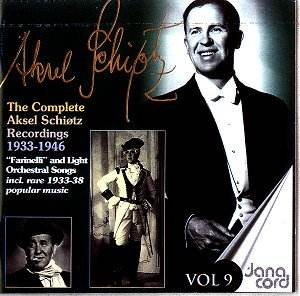Brief biographical notes on the great Danish tenor
Aksel Schiøtz can be found in my review
of Vol. 1.
The chronological survey of Danish song, begun with
Vol. 5 and continued in Vols. 6 and 8, will conclude with Vol. 10, dedicated
entirely to Carl Nielsen. Meanwhile Vol. 9 takes a detour through more
ephemeral, though entertaining, material. First we have four extracts
from an operetta by Reesen; the sort of agreeable but instantly forgettable
operetta stuff that was produced by the yard in the 1930s and 1940s.
Schiøtz is in creamy voice and knows the right style. Arne Helman’s
notes, as useful as ever, point out that when the operetta was produced,
in 1942 under the Nazi occupation, the Danes were good at decoding political
messages and well understood that the final song in honour of the King
of Spain and the dream of a land of peace and freedom was really about
another king and another land entirely.
Only a few items require comment. "Night and Day"
is well sung, if hardly in cabaret style. Schiøtz sang it, not
as a bid to be recognised as an exponent of the American musical, but
for the sheer hell of singing music that the Nazis considered to be
"degenerate". Mogens Schrader’s I de lyse nætter
sounded like drawing-room music in the piano version in Vol. 7.
Here the glutinous orchestra just about puts the tin lid on it. "Denmark’s
Freedom Song" was finally performed in Denmark itself on Liberation
Day (an incomplete recording of this broadcast is preserved in Vol.
8). Before that Schiøtz recorded it in Sweden; it was smuggled
out and played by "BBC sender til Danmark" (many times).
After these "official" light music recordings
by Schiøtz we have documentation of his first visits to the recording
studios. In 1933 he got a couple of solos in the medley "Film-cuttings"
and can also be heard in the ensemble. The bandleader Erik Tuxen is
that very same who became conductor of the Danish Radio Symphony Orchestra
and made some important Nielsen recordings. Then in 1934, with his name
spelt wrong and described as a baritone, Schiøtz had a small
part in Christensen’s Jazz-oratorio The 24 Hours and two years
later was in the male trio (without a solo part) in the same composer’s
The School Upside Down. The ubiquitous Mogens Wöldike has
some fun here. Incidentally, among the Five Syncopes and the Three Rhythm
Girls was Grete Kordt who had graduated to pianist by 1936 and who played
for a number of Schiøtz’s later recordings.
In conclusion, following the practice of many of Schiøtz’s
contemporary singers, including his Swedish colleague Jussi Björling,
of recording light music under a pseudonym, we have six sides which
he cut as "The Masked Tenor". He makes no attempt to mask
his voice, so the unmasking must have come pretty quickly. Fun to hear
once, particularly Ankerstjerne’s outrageous references to Dvořák’s
“Songs my Mother Taught Me”.
This volume contains none of the recordings which will
guarantee Schiøtz a place in history. If, like me, you have been
following this series and have developed a fondness for Schiøtz,
I think you will enjoy this glimpse of his lighter side and his first
recordings. It is certainly a sobering reflection that, although the
series says "Complete Recordings 1933-1946", the real solo
recordings before an international public began in 1938, were limited
to Denmark and mainly Danish music from 1940-1945, and began again in
1945 only to be truncated the following year by the operation which
practically ended his career. Yet in just three years of international
career Schiøtz came to be considered one of the greatest lieder
singers, and his recorded legacy, though small, is enough to justify
this reputation.
Christopher Howell



